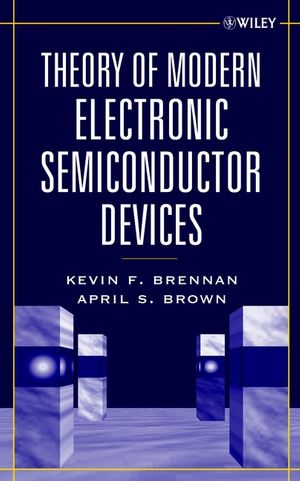Theory of Modern Electronic Semiconductor DevicesISBN: 978-0-471-41541-1
Hardcover
448 pages
March 2002
 This is a Print-on-Demand title. It will be printed specifically to fill your order. Please allow an additional 15-20 days delivery time. The book is not returnable.
|
||||||
PREFACE.
1 OVERVIEW OF SEMICONDUCTOR DEVICE TRENDS.
1.1 Moore's Law and Its Implications.
1.2 Semiconductor Devices for Telecommunications.
1.3 Digital Communications.
2 SEMICONDUCTOR HETEROSTRUCTURES.
2.1 Formation of Heterostructures.
2.2 Modulation Doping.
2.3 Two-Dimensional Subband Transport at Heterointerfaces.
2.4 Strain and Stress at Heterointerfaces.
2.5 Perpendicular Transport in Heterostructures and Superlattices.
2.6 Heterojunction Materials Systems: Intrinsic and Extrinsic Properties.
Problems.
3 HETEROSTRUCTURE FIELD-EFFECT TRANSISTORS.
3.1 Motivation.
3.2 Basics of Heterostructure Field-Effect Transistors.
3.3 Simplified Long-Channel Model of a MODFET.
3.4 Physical Features of Advanced State-of-the-Art MODFETs.
3.5 High-Frequency Performance of MODFETs.
3.6 Materials Properties and Structure Optimization for HFETs.
Problems.
4 HETEROSTRUCTURE BIPOLAR TRANSISTORS.
4.1 Review of Bipolar Junction Transistors.
4.2 Emitter-Base Heterojunction Bipolar Transistors.
4.3 Base Transport Dynamics.
4.4 Nonstationary Transport Effects and Breakdown.
4.5 High-Frequency Performance of HBTs.
4.6 Materials Properties and Structure Optimization for HBTs .
Problems.
5 TRANSFERRED ELECTRON EFFECTS, NEGATIVE DIFFERENTIAL RESISTANCE, AND DEVICES.
5.1 Introduction.
5.2 k-Space Transfer.
5.3 Real-Space Transfer.
5.4 Consequences of NDR in a Semiconductor.
5.5 Transferred Electron-Effect Oscillators: Gunn Diodes.
5.6 Negative Differential Resistance Transistors.
5.7 IMPATT Diodes.
Problems.
6 RESONANT TUNNELING AND DEVICES.
6.1 Physics of Resonant Tunneling: Qualitative Approach.
6.2 Physics of Resonant Tunneling: Envelope Approximation.
6.3 Inelastic Phonon Scattering Assisted Tunneling: Hopping Conduction.
6.4 Resonant Tunneling Diodes: High-Frequency Applications.
6.5 Resonant Tunneling Diodes: Digital Applications.
6.6 Resonant Tunneling Transistors.
Problems.
7 CMOS: DEVICES AND FUTURE CHALLENGES.
7.1 Why CMOS?
7.2 Basics of Long-Channel MOSFET Operation.
7.3 Short-Channel Effects.
7.4 Scaling Theory.
7.5 Processing Limitations to Continued Miniaturization.
Problems.
8 BEYOND CMOS: FUTURE APPROACHES TO COMPUTING HARDWARE.
8.1 Alternative MOS Device Structures: SOI, Dual-Gate FETs, and SiGe.
8.2 Quantum-Dot Devices and Cellular Automata.
8.3 Molecular Computing.
8.4 Field-Programmable Gate Arrays and Defect-Tolerant Computing.
8.5 Coulomb Blockade and Single-Electron Transistors.
8.6 Quantum Computing.
Problems.
9 MAGNETIC FIELD EFFECTS IN SEMICONDUCTORS.
9.1 Landau Levels.
9.2 Classical Hall Effect.
9.3 Integer Quantum Hall Effect.
9.4 Fractional Quantum Hall Effect.
9.5 Shubnikov-de Haas Oscillations.
Problems.
REFERENCES.
APPENDIX A: PHYSICAL CONSTANTS.
APPENDIX B: BULK MATERIAL PARAMETERS.
Table I: Silicon.
Table II: Ge.
Table III: GaAs.
Table IV: InP.
Table V: InAs.
Table VI: InN.
Table VII: GaN.
Table VIII: SiC.
Table IX: ZnS.
Table X: ZnSe.
Table XI : Al x Ga 1 fx As.
Table XI I : Ga 0:47 In 0:53 As.
Table XIII: Al 0:48 In 0:52 As.
Table XI V: Ga 0:5 In 0:5 P.
Table XV: Hg 0:70 Cd 0:30 Te.
APPENDIX C: HETEROJUNCTION PROPERTIES.
INDEX.
1 OVERVIEW OF SEMICONDUCTOR DEVICE TRENDS.
1.1 Moore's Law and Its Implications.
1.2 Semiconductor Devices for Telecommunications.
1.3 Digital Communications.
2 SEMICONDUCTOR HETEROSTRUCTURES.
2.1 Formation of Heterostructures.
2.2 Modulation Doping.
2.3 Two-Dimensional Subband Transport at Heterointerfaces.
2.4 Strain and Stress at Heterointerfaces.
2.5 Perpendicular Transport in Heterostructures and Superlattices.
2.6 Heterojunction Materials Systems: Intrinsic and Extrinsic Properties.
Problems.
3 HETEROSTRUCTURE FIELD-EFFECT TRANSISTORS.
3.1 Motivation.
3.2 Basics of Heterostructure Field-Effect Transistors.
3.3 Simplified Long-Channel Model of a MODFET.
3.4 Physical Features of Advanced State-of-the-Art MODFETs.
3.5 High-Frequency Performance of MODFETs.
3.6 Materials Properties and Structure Optimization for HFETs.
Problems.
4 HETEROSTRUCTURE BIPOLAR TRANSISTORS.
4.1 Review of Bipolar Junction Transistors.
4.2 Emitter-Base Heterojunction Bipolar Transistors.
4.3 Base Transport Dynamics.
4.4 Nonstationary Transport Effects and Breakdown.
4.5 High-Frequency Performance of HBTs.
4.6 Materials Properties and Structure Optimization for HBTs .
Problems.
5 TRANSFERRED ELECTRON EFFECTS, NEGATIVE DIFFERENTIAL RESISTANCE, AND DEVICES.
5.1 Introduction.
5.2 k-Space Transfer.
5.3 Real-Space Transfer.
5.4 Consequences of NDR in a Semiconductor.
5.5 Transferred Electron-Effect Oscillators: Gunn Diodes.
5.6 Negative Differential Resistance Transistors.
5.7 IMPATT Diodes.
Problems.
6 RESONANT TUNNELING AND DEVICES.
6.1 Physics of Resonant Tunneling: Qualitative Approach.
6.2 Physics of Resonant Tunneling: Envelope Approximation.
6.3 Inelastic Phonon Scattering Assisted Tunneling: Hopping Conduction.
6.4 Resonant Tunneling Diodes: High-Frequency Applications.
6.5 Resonant Tunneling Diodes: Digital Applications.
6.6 Resonant Tunneling Transistors.
Problems.
7 CMOS: DEVICES AND FUTURE CHALLENGES.
7.1 Why CMOS?
7.2 Basics of Long-Channel MOSFET Operation.
7.3 Short-Channel Effects.
7.4 Scaling Theory.
7.5 Processing Limitations to Continued Miniaturization.
Problems.
8 BEYOND CMOS: FUTURE APPROACHES TO COMPUTING HARDWARE.
8.1 Alternative MOS Device Structures: SOI, Dual-Gate FETs, and SiGe.
8.2 Quantum-Dot Devices and Cellular Automata.
8.3 Molecular Computing.
8.4 Field-Programmable Gate Arrays and Defect-Tolerant Computing.
8.5 Coulomb Blockade and Single-Electron Transistors.
8.6 Quantum Computing.
Problems.
9 MAGNETIC FIELD EFFECTS IN SEMICONDUCTORS.
9.1 Landau Levels.
9.2 Classical Hall Effect.
9.3 Integer Quantum Hall Effect.
9.4 Fractional Quantum Hall Effect.
9.5 Shubnikov-de Haas Oscillations.
Problems.
REFERENCES.
APPENDIX A: PHYSICAL CONSTANTS.
APPENDIX B: BULK MATERIAL PARAMETERS.
Table I: Silicon.
Table II: Ge.
Table III: GaAs.
Table IV: InP.
Table V: InAs.
Table VI: InN.
Table VII: GaN.
Table VIII: SiC.
Table IX: ZnS.
Table X: ZnSe.
Table XI : Al x Ga 1 fx As.
Table XI I : Ga 0:47 In 0:53 As.
Table XIII: Al 0:48 In 0:52 As.
Table XI V: Ga 0:5 In 0:5 P.
Table XV: Hg 0:70 Cd 0:30 Te.
APPENDIX C: HETEROJUNCTION PROPERTIES.
INDEX.



